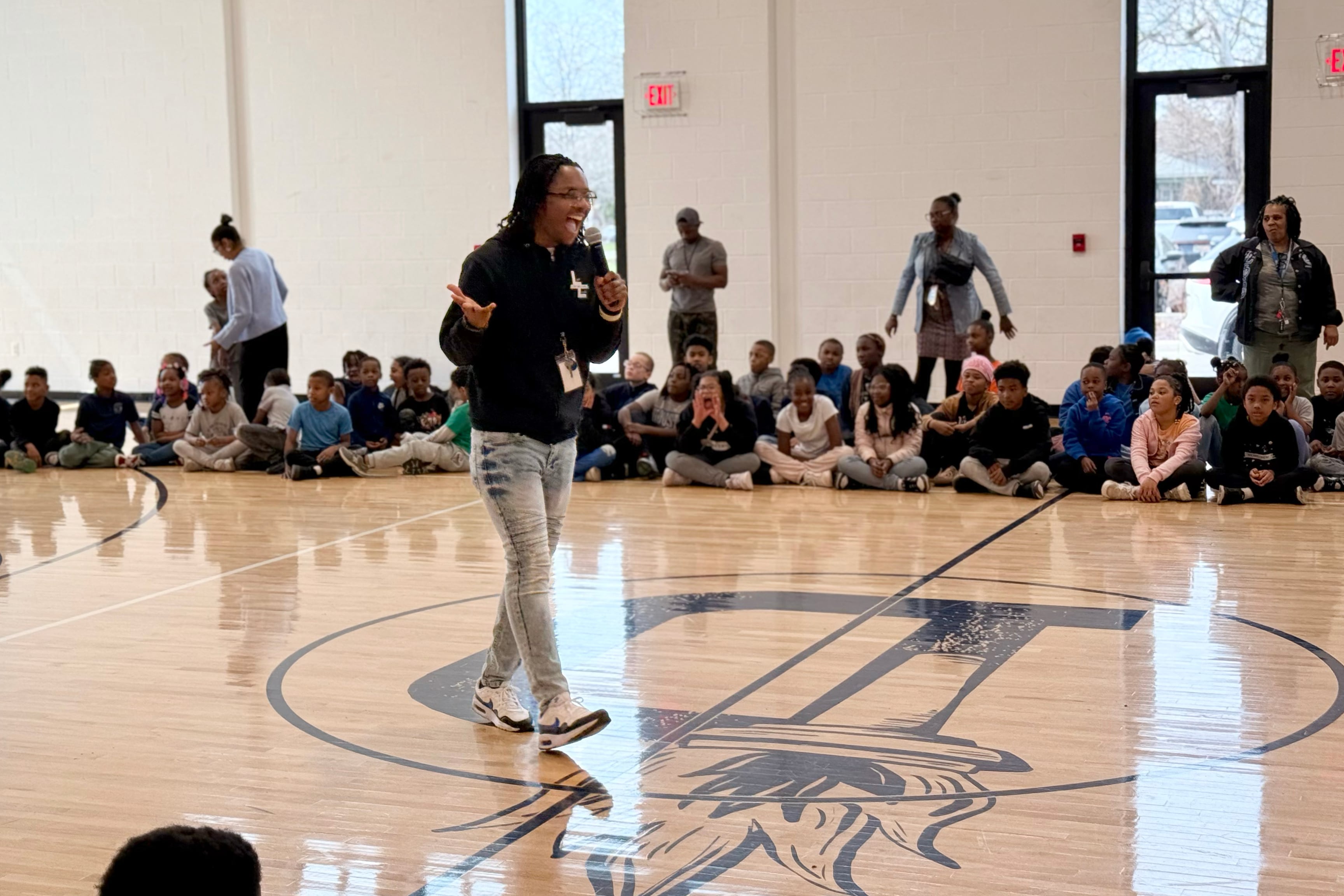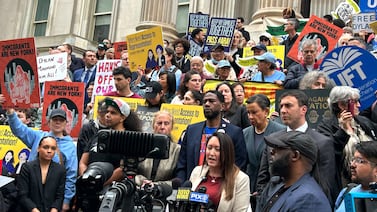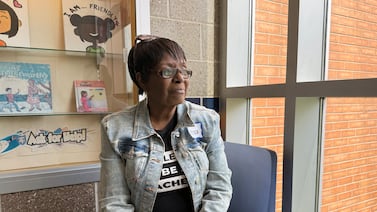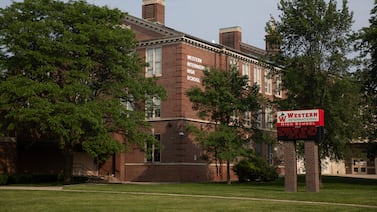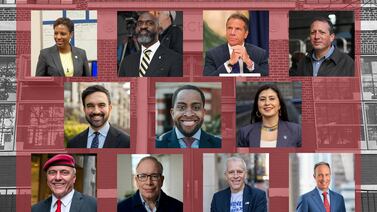Sign up for Chalkbeat’s free monthly newsletter How I Teach to get inspiration, news, and advice for — and from — educators.
Mario Lemons leads a school in the same westside Detroit neighborhood where he grew up, and just a block away from the high school from which he graduated.
“I know the students, families, and teachers,” said Lemons, the head of school at Detroit Achievement Academy, a charter on West Outer Drive. “I know them figuratively because they are a product of this community, just like I am, so there’s a strong cultural and communal connection and understanding that can only come from a shared lived experience.”
It doesn’t end there, though. Lemons said many of the teachers at the academy “are people who I literally grew up with, and many of the students at DAA are children of parents who I also grew up with.”
Lemons is one of 10 Detroit educators (see full list below) who were recently honored as a 2025 Skillman Visionary by the Skillman Foundation. The annual awards program recognizes education changemakers. (The Skillman Foundation is a Chalkbeat funder.) Winners include people ranging from a foster care advocate to a teacher leader and curriculum designer.
Lemons, who, growing up, attended Paul Robeson Academy, Detroit Open School, and Renaissance High School, has been the head of school at DAA for six years and prior to that was the school’s behavior interventionist. He began his career as a teacher.
As a child, Lemons was involved with the Mosaic Youth Theatre of Detroit, an experience that shaped his love of the arts. It’s something he’s worked to instill in the students he serves.
“The arts are such a unique opportunity for students to express themselves, strengthen their confidence and identity, as well as draw parallels to core academic content.”
Growing up, he said, “the theater arts undeniably strengthened my reading, writing, and speaking skills. Music and visual arts helped me make strong connections to mathematical concepts such as fractions and geometry.”
Lemons spoke with Chalkbeat about his experience with school, empowering young people, fostering teacher morale, and how he started learning American Sign Language.
This interview has been lightly edited for length and clarity.
What led you to a career in education?
I felt led to go into education during my senior year in high school while walking to school and praying about my future. I wanted to do something that would make a difference in the lives of young people the way that adults in my community impacted my life growing up.
Tell us about your own experience with school and how it affects your work today.
I grew up in a community where everyone believed in the African proverb “It takes a village to raise a child.” So I was educated by every adult that I interacted with in school, church, and [Mosaic] youth theater company, etc. My elementary school was an Afrocentric school where that philosophy was embedded into how I viewed elders and their roles in inspiring me to reach my highest potential for the greater good of the community. This affects my work today because I instill that same “village” mindset into our school community. It takes all of us to educate our children — school staff, students’ families, experts in the community, and neighborhood leaders to produce the best outcomes for students. So I leverage all stakeholders as best I can.
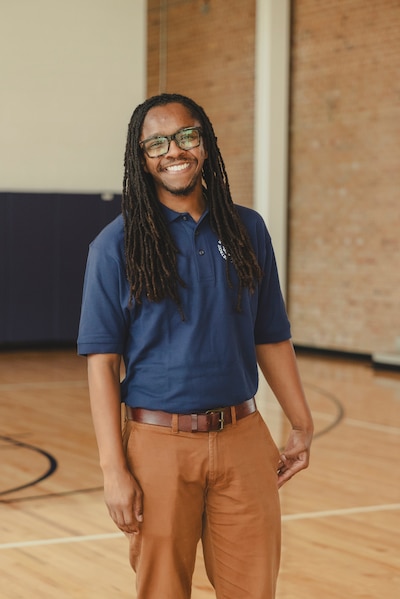
I often tell my staff, “If we do this right, our students will grow up to be the community members who keep our neighborhoods and society safe, creative, cooperative, and productive. That’s how powerful our role is in the community! Don’t ever take that lightly at all.”
What’s the best advice you ever received — and how have you put it into action?
The best advice I ever received was early in my education career, and it was “Forgive yourself every night; and rededicate yourself every morning.” I still use that advice on my toughest days as a school leader. Not everything will always go as planned, but as long as I give it my best, I can sleep at night, and try again with renewed energy and purpose in the morning.
What’s one thing you’ve read that has made you a better educator?
I have been so inspired by the work of [educator and writer] Elena Aguilar. I have read almost all of her books, and her work on cultivating emotional resilience has allowed me to be stronger in my presence and efforts in education each day. But it also gives me an awareness of how to more effectively interact with staff, students and families no matter what state of being they are in.
In recent years, many students have faced mental health challenges. How has your team helped support them at this time?
As a district, we have continued to prioritize having a full-time school social worker in our buildings every day throughout the school year. We also have contracted a clinical therapist to assist our students who need more intensive mental and social-emotional support than what a school social worker has the capacity to provide.
How do you take care of yourself when you’re not at work?
Over the years, I have established and maintained clear and inflexible boundaries between work and my personal life. This has helped me to have a sustainable balance between the two. I prioritize doing things that bring me joy, like roller skating every Monday night, volunteering at my church as a singer and a sign language interpreter for the deaf members, being involved in the vibrant arts community in Detroit, and traveling periodically as a vacation. This allows me to fill my “personal bucket” so that I can have the energy to continue doing the hard but great work of leading our school community day to day.
Your bio notes that you’ve dedicated yourself to empowering young people in creative spaces. What does that look like?
I have a background in theater and the performing arts. So I weave that into just about everything that I do — and I support, promote, and help to cultivate creativity with our young people in many different ways. We hired and retained a full-time dance teacher, a full-time art teacher, and a part-time instrumental music teacher. Over the years at DAA, I also have taught drama/theater during and after school; and I taught American Sign Language, where students learned sign language and were able to perform a song in ASL. I have coached students on creative writing and speech. Outside of school, I have taught youth theater classes, produced theatrical productions, directed plays, and consulted for arts organizations that gave young people opportunities to express themselves creatively. No matter what I am doing, my natural inclination is to incorporate and foster students’ creative talents as well.
What do you do to improve teacher morale? How do you address your own morale?
I am a “people first” kind of person, so improving teacher morale starts with acknowledging them as human beings first. I listen, and I lead firmly but with compassion. I am able to connect with my teachers on a personal level to inspire them to stay positive easily because I establish and maintain a meaningful relationship with them every single day throughout the school year. As I model this type of relationship with my staff, I create opportunities for staff to model it amongst their peers during staff meetings, professional development, and whole-school assemblies and events.
We also ensure that staff have everything they need to do their jobs well — supplies, competitive salaries, snacks in the staff lounge, consistent instructional coaching, ample amount of prep and planning time, student behavior support, positive public and private praise and appreciation, and clear and consistent communication from leadership. All of that makes for a wonderful teacher working environment, and seeing my staff joyful and excited to be at work boosts my morale as well!
How long have you used American Sign Language, and how did you learn it?
I learned ASL when I was about 12 years old by simply sitting in the front row at church watching the sign language interpreter interpret during the Sunday morning services. After a few weeks of me talking to the interpreter after church about the vocabulary that I was learning, she started to teach me more words so I can practice interpreting the songs. As the years went on, I learned enough vocabulary to be confident to interpret the pastor’s sermon and, in some cases, the entire church service. I have continued to hone that skill over time and found joy in interpreting at churches around the city for the past 20-plus years.
I used ASL when I was a classroom teacher as a fun way for students to memorize their spelling words. An activity they would do would be to spell their words using ASL. Oftentimes, if I am explaining a concept or a hard academic word and I realize that, in ASL, visually, it looks like the meaning of the word, then I would teach the sign for it to help students understand the meaning of the word. I also use it to teach students how to greet one another in sign language — Good morning/afternoon. How are you? Good. Happy. Sad. One year, I had a non-verbal student at our school, and I would interpret for her when necessary.
Lori Higgins is the bureau chief for Chalkbeat Detroit, and writes about Detroit schools. You can reach her at lhiggins@chalkbeat.org.

